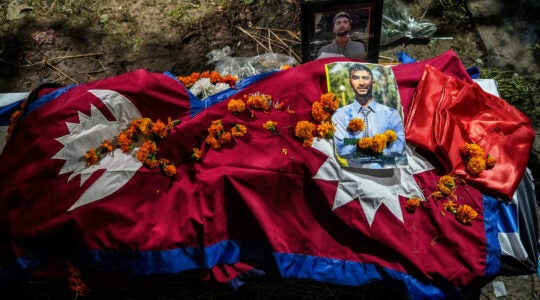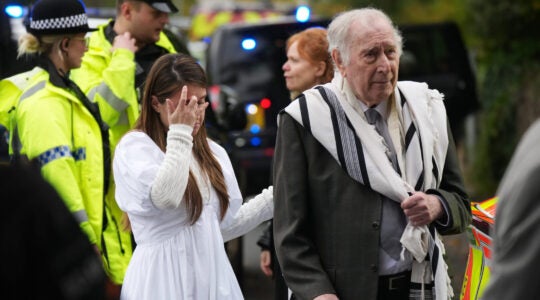NEW YORK (JTA) – Who knew what, and when?
Those are the questions critics are asking following the disclosure that the Claims Conference received an anonymous letter in 2001 identifying several fraudulent Holocaust-era restitution claims — nearly a decade before the organization halted a massive fraud scheme.
By 2009, when the magnitude of the scheme was discovered, the fraud had been running for 15 years and managed to extract more than $57 million in illegitimate payouts.
Last Friday, World Jewish Congress President Ronald Lauder sent a letter to the Claims Conference’s chairman, Julius Berman, and executive vice president, Greg Schneider, demanding answers to whether the 2001 episode was ever disclosed to Claims Conference board members.
“We have received numerous inquiries of concern in the wake of news stories in the Forward, the New York Jewish Week and JTA regarding the existence of an anonymous letter dated June 6, 2001 that apparently raised questions with respect to the fraud being perpetrated against the Claims Conference,” Lauder wrote.
In a separate letter, Lauder referred to allegations of a cover-up, calling them a “long-term issue with potentially serious implications,” and announcing that the WJC, which has a seat on the Claims Conference board, was forming a task force to investigate, The Jerusalem Post reported.
On Sunday, Berman emailed the Claims Conference board to say that he had asked the chairman of the board’s executive, former Israeli diplomat Reuven Merhav, to “head a Select Leadership Committee of the board to formulate an appropriate course of action for the Conference with respect to the issues surrounding the 2001 letter.”
The brouhaha was sparked by a May 14 story in the Forward newspaper about the existence of the 2001 letter.
Though the Forward reported it first, the discovery of the letter was no journalistic scoop: The letter had been introduced as evidence in the corruption trial of the ringleader of the fraud, Semen Domnitser, and was discussed at length during the courtroom proceedings.
Domnister was queried in 2001 about the allegations in the anonymous letter, and the prosecution used the episode to show how Domnitser in his response shrewdly managed to keep his superiors from discovering that he was perpetrating an ongoing fraud.
The trial, which concluded this month, resulted in the conviction of Domnitser and two other defendants on all counts, bringing guilty pleas or verdicts to all 31 people arrested in connection with the fraud.
The original Forward story appears to have gotten some key facts wrong: It said the current chief of the Claims Conference, Schneider, had received a copy of the anonymous letter in 2001, and the letter subsequently sent to Domnitser questioning him about the allegations. But there is no evidence that Schneider saw either of the letters. Rather, Schneider was one of several people that Domnitser CC’d on his 2001 responses, the Claims Conference says. (The Forward story was later changed online, but failed to note that corrections had been made.)
The way the anonymous letter was handled in 2001 and during the run-up to the recent trial is important to understanding whether there was an attempt to cover up the 2001 episode and who ultimately is to blame for bungling the early warning of the fraud.
Critics of the Claims Conference, such as longtime gadfly Isi Leibler, a former Jewish organizational official from Australia who now lives in Israel and writes a column for The Jerusalem Post, called the mishandling of the 2001 episode evidence of “gross negligence” at the Holocaust restitution organization. Leibler alleged that Berman and Schneider engaged in “systematic and deliberate efforts to conceal the incompetence and breakdown of their management and leadership which enabled this fraud to occur under their very noses.”
Berman could not be reached for comment, and Schneider declined to speak to JTA on the record.
The Claims Conference, which controls the distribution of hundreds of millions of dollars per year, is a frequent target of critics who disagree with the group’s allocations and see its leaders as a club of insiders that is unresponsive to outsiders. The critics say the fact that the fraud was able to run undetected from 1993 to 2009 and run up a bill – ultimately paid by Germany – of more than $57 million in false claims is evidence that Claims Conference leaders are not doing an adequate job.
“It was outrageous that the management responsible for overseeing these funds failed to accept any responsibility or accountability,” Leibler wrote in his column.
The fraud involved falsifying applications to the Hardship Fund, an account established by the German government to provide one-time payments of approximately $3,360 to those who fled the Nazis as they moved east through Germany, and the Article 2 Fund, through which the German government gives pension payments of approximately $411 per month to needy Nazi victims who spent significant time in a concentration camp, in a Jewish ghetto in hiding or living under a false identity to avoid the Nazis. Domnitser oversaw the two funds.
Though $57 million was stolen in the scheme, no genuine Holocaust survivors were deprived of any money. Germany has borne the cost of the fraudulent payouts, and several million dollars of the stolen money has been recouped.
On the question of who ultimately is responsible for bungling the 2001 episode, Claims Conference spokeswoman Hillary Kessler-Godin pointed to Karl Brozik, the head of the Claims Conference office in Frankfurt, Germany, which received the anonymous letter. Brozik, who died in 2004, handled the review of the letter’s allegations.
When the letter was brought to his attention in 2001, Brozik had a Claims Conference caseworker, Julia Gafsi, assess whether there was any merit to the allegations, according to Claims Conference documentation. Gafsi found numerous questionable elements.
Brozik then queried Domnitser, who was responsible for approving the claims in New York. In his response to Brozik, Domnitser acknowledged some inadvertent errors but lied about other facts in a bid to deflect attention from his fraud scheme.
Among those who were CC’d on Domnitser’s responses to Brozik were former Claims Conference head Saul Kagan; its chief at the time, Gideon Taylor; and Schneider, who in 2001 was assistant executive vice president and director of allocations.
Domnitser’s feint apparently was successful. Brozik forwarded Domnitser’s responses to the caseworker who had conducted the review, and though the caseworker said there still were elements of the story that seemed strange, Brozik appears to have let the matter end there.
As the only senior official of all those involved in the episode who still works at the Claims Conference, Schneider’s role in the episode has come under great scrutiny.
The Claims Conference spokeswoman, Kessler-Godin, says Schneider is not to blame because he never saw the original letter, the other people CC’d on the correspondence were senior to Schneider and Brozik ultimately was responsible.
She also noted that it was Schneider and colleague Karen Heilig who discovered the fraud in November 2009 and subsequently alerted the FBI to the scheme. After he found the documentation from 2001, Schneider was the one who brought it to the attention of the FBI, Kessler-Godin said.
But Claims Conference officials have yet to answer Lauder’s question about whether the 2001 episode was shared with the organization’s board and, if not, why.
(This story has been modified from its original version to reflect a correction.)
JTA has documented Jewish history in real-time for over a century. Keep our journalism strong by joining us in supporting independent, award-winning reporting.





